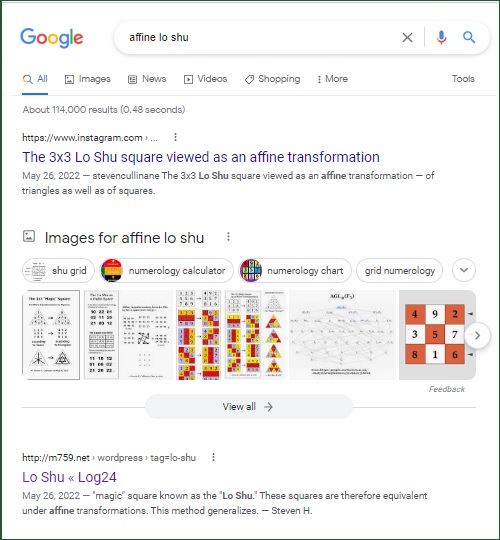
Tuesday, May 9, 2023
Plan 9: The Center
Thursday, February 16, 2023
Reaching the Stillness
See http://m759.net/wordpress/?s="Mac+Lane"+Boolean.
An image from that search —
 .
.
A related image
for T. S. Eliot:

Thursday, August 25, 2022
Meditation on a Song Lyric
"I saw a werewolf with a Chinese menu in his hand
Walking through the streets of Soho in the rain"
See other posts now tagged Structure Character.
Friday, May 20, 2022
Squares to Triangles
Sunday, June 16, 2019
Eliot’s Perpetual Motion Structure*
From a date described by Peter Woit in his post
“Not So Spooky Action at a Distance” (June 11) —
See also The Lost Well.
* “As a Chinese jar….” — Four Quartets
Monday, June 3, 2019
Jar Story
“. . . Only by the form, the pattern,
Can words or music reach
The stillness, as a Chinese jar still
Moves perpetually in its stillness.”
— T. S. Eliot, Four Quartets
From Writing Chinese Characters:
“It is practical to think of a character centered
within an imaginary square grid . . . .
The grid can… be… subdivided, usually to
9 or 16 squares. . . .“

These “Chinese jars” (as opposed to their contents)
are as follows:
 .
.
See as well Eliot’s 1922 remarks on “extinction of personality”
and the phrase “ego-extinction” in Weyl’s Philosophy of Mathematics —

Friday, July 6, 2018
Something
"… Only by the form, the pattern,
Can words or music reach
The stillness, as a Chinese jar still
Moves perpetually in its stillness."
— T. S. Eliot, "Burnt Norton," 1936
"Read something that means something."
— Advertising slogan for The New Yorker
The previous post quoted some mystic meditations of Octavio Paz
from 1974. I prefer some less mystic remarks of Eddington from
1938 (the Tanner Lectures) published by Cambridge U. Press in 1939 —
"… we have sixteen elements with which to form a group-structure" —

See as well posts tagged Dirac and Geometry.
Sunday, July 1, 2018
Friday, November 19, 2004
Friday November 19, 2004
From Tate to Plato
In honor of Allen Tate's birthday (today)
and of the MoMA re-opening (tomorrow)
"For Allen Tate the concept of tension was the most useful formal tool at the critic’s disposal, as irony and paradox were for Brooks. The principle of tension sustains the whole structure of meaning, and, as Tate declares in Tension in Poetry (1938), he derives it from lopping the prefixes off the logical terms extension and intension (which define the abstract and denotative aspect of the poetic language and, respectively, the concrete and connotative one). The meaning of the poem is 'the full organized body of all the extension and intension that we can find in it.' There is an infinite line between extreme extension and extreme intension and the readers select the meaning at the point they wish along that line, according to their personal drives, interests or approaches. Thus the Platonist will tend to stay near the extension end, for he is more interested in deriving an abstraction of the object into a universal…."
— from Form, Structure, and Structurality,
by Radu Surdulescu
"Eliot, in a conception comparable to Wallace Stevens' 'Anecdote of the Jar,' has suggested how art conquers time:
Only by the form, the pattern,
Can words or music reach
The stillness, as a Chinese jar still
Moves perpetually in its stillness."
— F. O. Matthiessen
in The Achievement of T.S. Eliot,
Oxford University Press, 1958
From Writing Chinese Characters:
"It is practical to think of a character centered within an imaginary square grid…. The grid can… be… subdivided, usually to 9 or 16 squares…."

These "Chinese jars"
(as opposed to their contents)
are as follows:

Various previous Log24.net entries have
dealt with the 3×3 "form" or "pattern"
(to use the terms of T. S. Eliot).
For the 4×4 form, see Poetry's Bones
and Geometry of the 4×4 Square.







